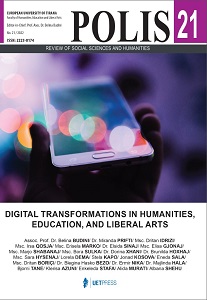Close up theater - an innovation in stage art studies
Close up theater - an innovation in stage art studies
Author(s): Dritan BoriçiSubject(s): Theatre, Dance, Performing Arts, Media studies, Music, Visual Arts, Health and medicine and law, ICT Information and Communications Technologies, Sociology of Art
Published by: Shtëpia botuese “UET Press”
Keywords: Close up theater; innovation; stage art studies;
Summary/Abstract: In this article we will try to offer a new perspective on the theater, and we will try to include the theater in other spaces to create artistic values, including digital technology. Since its beginning, the theater space has been a place to see, to watch, to present, to perceive, to understand. So, in a basic sense, theater has been and is a first pathway. At the core of the theatrical experience – as Peter Brook suggests – is the act of watching and being watched. Throughout the history of Western culture, the theater has been a primitive dance circle, a Greek amphitheater, a church, an Elizabethan stage, a market square, a garage, a street, a front stage theater, a Broadway theater, a theater house university, a restored warehouse or recently, even a digital platform on our laptop, computer, or mobile phone. Close-up theater is a continuation of the conceptual changes that took place with theater spaces – and therefore – with the way of watching theater. In the past decades, Jerzy Grotowski in Poland, Ariane Mnoushkin in Paris, Peter Shuman in Vermont and Peter Brook from Africa in Avignon, France, have organized the theater space in different ways to bring the audience and the actors as close as possible to each other. Peter Brook discovered one of the most significant axioms of future theater development by concluding: “I can take any empty space and call it a bare stage. A man walks along this empty space while someone else is watching him, and that is all that is needed to be the starting point for an act of theater.” So, our computer screen is also an empty space where a man (actor) appears in front of us at a predetermined moment and we see him, a starting point for a theater act – recently labeled the theater of the relative plane. The signs of close-up theater can also be found in other performances, on the Albanian and world stage, but this way of making theater had its rapid development during the global quarantine imposed by COVID 19. Theaters all over the world interrupted the repertoire with their premieres. Until those moments, digital technology had contributed a lot to the process of advertising the show, being an important part of publicity. Facebook, YouTube, etc. they distributed posters, the processes of preparing a show, or interviews of theater makers, critical articles, various information, to stimulate the interest of the spectator. As a result, the elements of a close-up theater were born: 1. Demand for investment in digital technology 2. The necessity to rediscover virtual artistic forms. 3. Adaptation of the home environment to work environment for artistic production. 4. Elements such as mobile phone, computer, laptop, - internet for the realization of the production. 5. The whole process of tests is feasible including individual and collective tests. 6. The process of improvisation and mixing with live music is realized.
Journal: Polis
- Issue Year: 1/2022
- Issue No: 21
- Page Range: 128-137
- Page Count: 10
- Language: English

